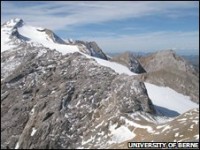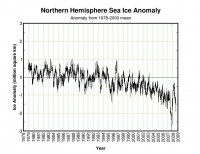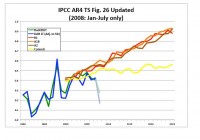By Blurbat blogspot
Freeman Dyson recently wrote that in order to understand global warming it must be understood as religion. More evidence for this comes from a recent article from BBC news. Many artifacts have been found recently in the Swiss Alps which indicate that these high mountain regions were readily accessible to humans. And interestingly, the dating of these artifacts corresponds to times when the Earth was calculated to be going through an especially warm period (around 3000 B.C.).
Dr. Holdren of Harvard University in a recent pro-alarmist polemic stated that the major reason for global warming alarmism is that the Earth is in an unprecedented phase of global warming. Well if our ancestors were encamped at the top of the alps a mere 5,000 years ago, then our current warming is not unprecedented...never mind the controversy about the medieval warm period.

An objective observer might say that everything’s more complicated than how the alarmists see it. The BBC article goes on to state that the warming that allowed habitation of the alps was caused by fluctuations in the orbital pattern of the Earth in relation to the Sun.
In my science classes I was taught the principle of uniformitarianism. This principle holds that the natural processes operating in the past are the same as those that can be observed operating today. But now we hear from Martin Grosjean, the climatologist studying the Alpine paleoclimate, that in the past the driving force for climate change was the Earth’s orbital pattern; now it’s greenhouse gasses.
This should be a story of major significance. The principle of uniformitarianism we were all taught in high school and college science class is dead. See blogspot here.
You knew it was coming. The alarmists and media have been frustrated in their efforts to report global warming evidence as nature has refused to cooperate. Temperatures have been declining for going on 7 years (accelerated this year) even as CO2 increased 3.5%. After a record low arctic ice extent last year, a cold winter brought Total Northern Hemisphere snow and ice cover to record high levels in January and arctic ice back to near normal. Snow and cold were replacing heat and drought in the news. They had to resort to blaming snowmelt and spring rain flooding and spring tornadoes and the annual western wildfires on global warming.
This summer, the media had to search for stories like a cracks in a Greenland glacier and the Wilkins Ice Sheet (ignoring experts stating that such cracks were not unusual) and a NSDIC press release that predicted this summer arctic ice might approach or exceed the record set last year because so much of the ice that formed was first year ice after the unusual wind patterns last summer dumped more than normal ice into the Atlantic. First year ice would be thinner and more easily melted.
Ironically just last year a NSIDC story correctly summarized the findings of many researchers and peer review papers that natural warming and cooling cycles in the Atlantic and Pacific were the real drivers for the cyclical changes in arctic ice over the centuries (as we have shown most recently here) when a scientist there correctly noted in October 2007:
“One prominent researcher, Igor Polyakov at the University of Fairbanks, Alaska, points out that pulses of unusually warm water have been entering the Arctic Ocean from the Atlantic, which several years later are seen in the ocean north of Siberia. These pulses of water are helping to heat the upper Arctic Ocean, contributing to summer ice melt and helping to reduce winter ice growth. Another scientist, Koji Shimada of the Japan Agency for Marine-Earth Science and Technology, reports evidence of changes in ocean circulation in the Pacific side of the Arctic Ocean. Through a complex interaction with declining sea ice, warm water entering the Arctic Ocean through Bering Strait in summer is being shunted from the Alaskan coast into the Arctic Ocean, where it fosters further ice loss. Many questions still remain to be answered, but these changes in ocean circulation may be important keys for understanding the observed loss of Arctic sea ice.”
This year that scientist was replaced by senior scientist Mark Serreze who predicted the ice might disappear and attributed the loss to global warming. This week he wrote and the media gladly reported the ice had diminished rapidly this month and now moved 2008 past 2005 into 2nd place behind 2007 in the record since it began in 1979.
The AP’s Seth Borenstein gleefully wrote: “More ominous signs Wednesday have scientists saying that a global warming “tipping point” in the Arctic seems to be happening before their eyes: Sea ice in the Arctic Ocean is at its second lowest level in about 30 years. Arctic ice always melts in summer and refreezes in winter. But over the years, more of the ice is lost to the sea with less of it recovered in winter. While ice reflects the sun’s heat, the open ocean absorbs more heat and the melting accelerates warming in other parts of the world. Sea ice also serves as primary habitat for threatened polar bears. “We could very well be in that quick slide downward in terms of passing a tipping point,” said senior scientist Mark Serreze at the data center in Boulder, Colo. “It’s tipping now. We’re seeing it happen now.” Within “five to less than 10 years,” the Arctic could be free of sea ice in the summer, said NASA ice scientist Jay Zwally. “It also means that climate warming is also coming larger and faster than the models are predicting and nobody’s really taken into account that change yet,” he said.”
The drop off this month occurred after a breakdown of the spring and summer pattern which caused shifts in the wind flows that broke up more thin ice than normal even though the air was cold. But the sun is vanishing and the air growing colder and the the melting is slowing. See this plot from the University of Illinois Cryosphere which monitors arctic ice. Note the blip up at the end indicating a slowing of the melt short of 2007.

See larger image here
And as for the warming coming more quickly than any model see here how the IPCC climate model forecasts from 2006 are performing relative to the actual temperatures. The yellow line makes the assumption that CO2 is not rising.

See larger image here See how Borenstein’s idol Hansen’s models are doing here. See pdf of this story here. See pdf of this story
Denver, CO—A coalition of leaders from the African American, civil rights, faith-based and veteran communities this week blasted several Members of Congress as “Punishers of the Poor,” saying that they all scored a perfect zero on an affordable energy voting scorecard. The six politicians who earned top honors as the “worst of the worst” among those supporting higher energy prices—and who were memoralized in a Punishers of the Poor deck of playing cards—are these:
Joker: House Speaker Nancy Pelosi
Joker: Senate Majority Leader Harry Reid
Ace of Spades: U.S. Senator Dick Durbin
Ace of Diamonds: U.S. Senator Barbara Boxer
Ace of Clubs: U.S. Rep. George Miller (D-CA)
Ace of Hearts: U.S. Rep. Ed Markey (D-MA)
Streaming video of the press conference to unveil the “Punishers of the Poor” at the Democratic National Convention in Denver can be seen here.
“These six politicians are the leaders and generals in charge of waging an unprecedented war on the poor,” said Niger Innis, National Spokesman for the Congress of Racial Equality and co-chairman of the Alliance to Stop the War on the Poor. “By pushing policies that restrict American energy supply and thus push prices higher, they are delivering daily punishment to low-income and poor families across the nation. What these politicians are doing is immoral, and we intend to wake up the American people to the fact that this war being waged in every city in America today.”
“We call this a war on the poor because high energy prices disproportionately impact America’s poor and low-income families,” said Bishop Harry Jackson, Chairman of the High Impact Leadership Coalition and national co-chair of the Alliance. “With prices expected to rise this winter from 25 to 50 percent, we are in a true crisis. These prices are actually a highly regressive tax on America’s most vulnerable citizens. The war on the poor must stop. To do that, we must increase our supply of all energy resources, including coal, oil and gas, nuclear power—and encourage greater conservation.”
“High prices hit poor families hardest,” said Bishop Phillip Porter, Chair of Colorado Consumers for Affordable Energy and the founder of All Nations Pentecostal Church of God in Christ in Aurora, Colorado. “A recent study shows that while median income families have to devote five cents on a dollar of their income to energy costs, poor families have to devote upwards of 50 cents on the dollar. That is fifty cents they can’t spend on health care, or education or food.” “The poor are being decimated by high energy prices, which are also driving up food costs and other necessities of life,” said Ralph Conner of the non-partisan Heartland Institute
Dennis Sykes, Chairman of Colorado Veterans for Energy Security, “Unless we as a nation become energy independent, we will have to continue sending U.S. troops overseas to die on foreign soil defending our access to foreign energy. That is unacceptable.”
The coalition leaders said the ongoing “punishers of the poor” expose will be bipartisan, with both Republicans and Democrats named as punishers.
Recently in Washington, D.C., leaders from the civil rights, African American, faith-based, senior, agriculture and consumer advocacy communities launched a national campaign to publicly unmask more than 100 politicians and 50 environmental extremist groups that are waging an immoral “war on the poor” by pushing policies that limit America’s ability to produce more America energy and drive energy prices skyward. See more here.



